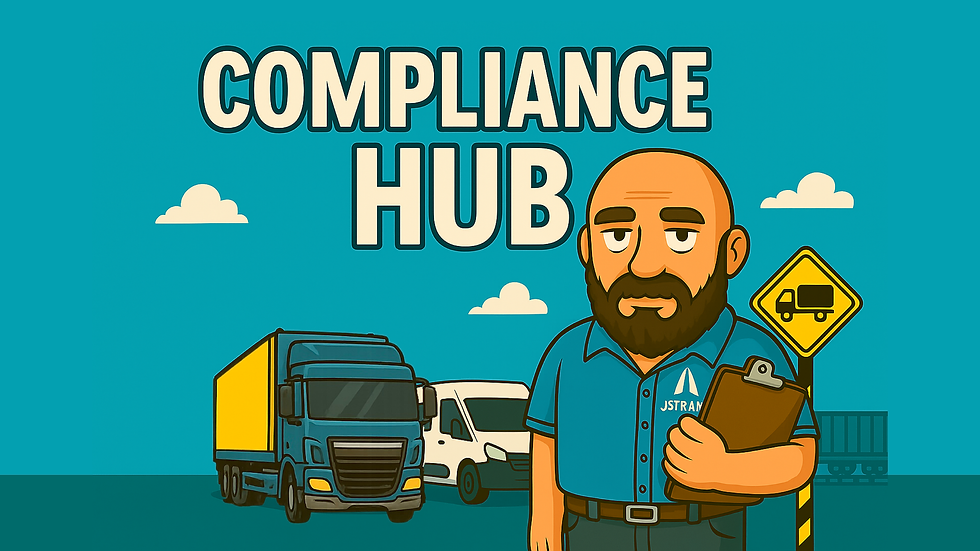Tachographs for Business Owners: Do You Really Need One?
- stuart47304
- Jul 14
- 4 min read

If you're running a small transport operation — especially under a Restricted Operator Licence — you may be wondering whether tachographs apply to you.
Maybe you only run locally.Maybe you don’t charge for transport.Maybe you’re driving under 100 km a day.
So… do you need a tachograph?
The answer is: maybe.Tachograph rules aren’t just for big fleets and international hauliers. Even small business owners can fall under the regulations — and getting it wrong can lead to:
DVSA penalties
Vehicle prohibitions
Public Inquiries
Fines and fixed penalties
This guide helps you cut through the confusion — and figure out exactly when a tachograph is required, when you're exempt, and what to do if you're in the grey area.
🚛 What Is a Tachograph?
A tachograph is a device fitted to commercial vehicles that records:
Driving time
Breaks and rest periods
Vehicle speed
Distance travelled
Driver identity (via smart card)
There are two main types:
Digital tachographs – Required in most modern vehicles over 3.5 tonnes
Analogue tachographs – Found in older vehicles, still legal in some contexts
Tachographs are used to enforce drivers’ hours rules — designed to prevent fatigue-related accidents.
⚖️ When Are Tachographs Legally Required?
Tachographs are required if:
✅ You are driving a vehicle over 3.5 tonnes gross vehicle weight (GVW)
✅ You are operating “in scope” of EU or GB drivers’ hours rules
✅ You are not exempt under specific rules
In scope means you're carrying goods for hire or reward (i.e. being paid to carry other people’s goods) OR for your own business but not qualifying for an exemption.
That includes:
Deliveries for your own company
Driving your own goods to site
Transporting tools, machinery, or construction materials
Yes — even if you’re not a haulier.
🛑 Common Exemptions (That May Apply to You)
You may not need a tachograph if your operation qualifies for an exemption.
Here are the most relevant ones for small business owners:
Exemption | What It Covers |
100km Radius (GB Domestic) | Driving within 100 km (62 miles) of your base AND not for hire or reward |
Goods vehicle under 3.5t GVW | No tacho required regardless of use |
Construction exemption | Carrying tools or equipment for your own work (certain trades) within 100 km |
Vehicles used for agriculture, horticulture, forestry, farming | Limited use exemptions available |
Vehicles used for non-commercial purposes | No hire/reward, and not part of a business |
Private use | Driving not linked to business or commercial gain |
⚠️ Be careful: Many exemptions are conditional. If one detail doesn’t fit, you may be in scope and need a tacho.
🤯 What Trips Up Small Operators?
Distance creep – regularly going just beyond the 100 km limit
Occasional longer trips – a “one-off” job puts you in scope
Hire & reward misunderstanding – charging customers for goods transport
Using multiple bases – where’s your “operating centre”?
Fitting a tachograph, but not using it – this is still non-compliance
📈 Restricted Licence? Still at Risk
Even with a Restricted O Licence, you must:
Follow all relevant driver hours and tachograph rules
Ensure compliance if your vehicle is in-scope, even occasionally
Retain tachograph records for 12 months minimum
Analyse data and investigate infringements
The lack of a Transport Manager doesn’t excuse non-compliance — it increases your responsibility.
📝 Do You Need a Tachograph Policy?
If you operate both exempt and non-exempt vehicles, or sometimes go over the 100 km limit, create a basic Tachograph Use Policy that covers:
Which vehicles need tachographs
When drivers must use their cards
Exemptions claimed and why
How records are downloaded and analysed
What action is taken on infringements
This protects you if DVSA or the Traffic Commissioner investigate your operation.
💳 What Equipment and Records Are Required?
If you operate in scope, you need:
Requirement | Details |
Digital Tachograph Unit | Installed in each vehicle |
Driver Smart Cards | Each driver must have one (apply via DVLA) |
Company Card | To lock data and access downloads |
Data Downloader | To extract data from vehicle and cards |
Record Keeping | Store data for at least 12 months |
Analysis System | Software or manual system to spot infringements |
Even if you only go in-scope once a month, you still need to follow these rules.
🔧 What If You Occasionally Go In and Out of Scope?
This is common for:
Builders delivering to a site over 100 km away
Suppliers doing occasional nationwide drops
Businesses attending trade shows or events
Best practice:
✅ Fit a digital tachograph (even if exempt most of the time)
✅ Instruct drivers to always carry their smart card
✅ Use the manual entry function to log out-of-scope work
✅ Log and justify exemptions in your record system
✅ Analyse any in-scope data properly
⚠️ Penalties for Non-Compliance
If you’re found operating in-scope without a tachograph, DVSA can issue:
Fixed penalties (£100 to £300+)
Vehicle prohibitions
Interviews under caution
Operator Licence investigations
Referral to Public Inquiry
Don’t assume “I didn’t know” will be accepted — you’re expected to be aware of the rules that apply to your operation.
🧠 Final Thoughts
If you operate a commercial vehicle over 3.5 tonnes, the question isn’t just “Do I need a tachograph?”It’s: “Am I in scope of the rules — today?”
As a business owner and Operator Licence holder, you must:
✅ Know the rules that apply to your journeys
✅ Identify when exemptions apply (and when they don’t)
✅ Use and maintain tachographs properly
✅ Analyse and act on the data
✅ Keep records for at least 12 months
Still unsure? It’s better to over-comply than under-comply. Fit the tacho, use the card, and show the DVSA you’re in control.
Next in the series:👉 Your Record-Keeping Checklist for Restricted Licence Compliance
